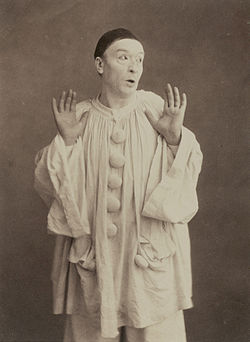
Pierrot (/ˈpɪəroʊ/ PEER-oh, US also /ˈpiːəroʊ, ˌpiːəˈroʊ/ PEE-ə-roh, PEE-ə-ROH; French: [pjɛʁo] ), a stock character of pantomime and commedia dell'arte, has his origins in the late 17th-century Italian troupe of players performing in Paris and known as the Comédie-Italienne. The name is a diminutive of Pierre (Peter), using the suffix -ot and derives from the Italian Pedrolino. His character in contemporary popular culture—in poetry, fiction, and the visual arts, as well as works for the stage, screen, and concert hall—is that of the sad clown, often pining for love of Columbine (who usually breaks his heart and leaves him for Harlequin). Performing unmasked, with a whitened face, he wears a loose white blouse with large buttons and wide white pantaloons. Sometimes he appears with a frilled collaret and a hat, usually with a close-fitting crown and wide round brim and, more rarely, with a conical shape like a dunce's cap.
Pierrot's character developed from that of a buffoon to become an avatar of the disenfranchised.[1] Many cultural movements found him amenable to their respective causes: Decadents turned him into a disillusioned foe of idealism; Symbolists saw him as a lonely fellow-sufferer; Modernists made him into a silent, alienated observer of the mysteries of the human condition.[2] Much of that mythic quality ("I'm Pierrot," said David Bowie: "I'm Everyman")[3] still adheres to the "sad clown" in the postmodern era.
- ^ Janin called Deburau's Pierrot "the people among the people" (pp. 156-57); Gautier identified him as "the modern proletarian, the pariah, the passive and disinherited being" (V, 24).
- ^ On Pierrot in the art of the Decadents and Symbolists, see Pantomime and late 19th-century art; for his image in the art of the Modernists, see, for example, the Juan Gris canvases reproduced in Works on canvas, paper, and board.[dead link]
- ^ Jean Rook, "Waiting for Bowie, and finding a genius who insists he's really a clown". Archived 2017-12-27 at the Wayback Machine, Daily Express, 5 May 1976.